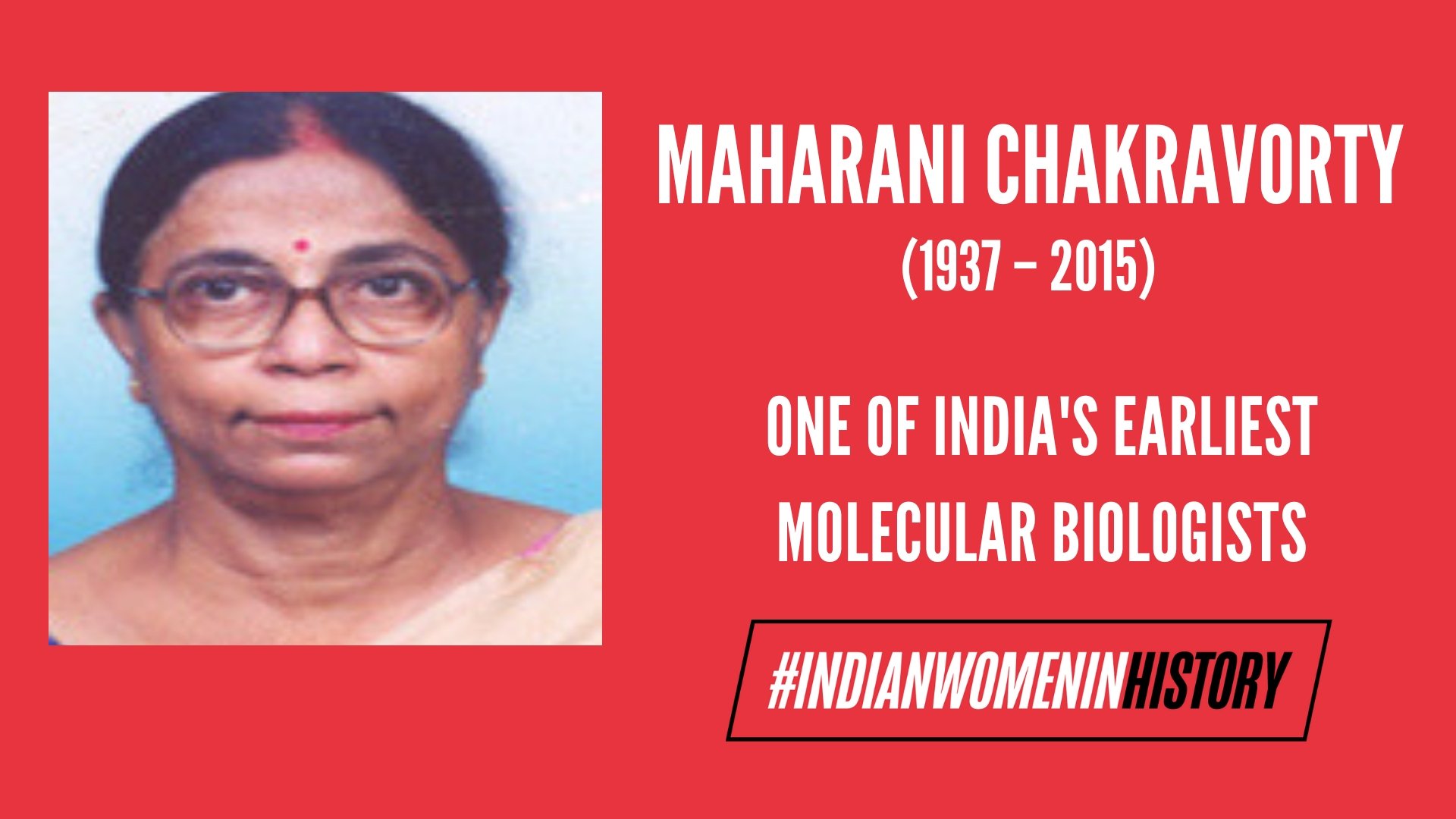This article is a part of the #IndianWomenInHistory campaign for Women’s History Month to remember the untold legacies of women who shaped India, especially India’s various feminist movements. One Indian woman is profiled each day for the whole of March 2019.
Genetics, DNA, RNA are some of the commonly used terms in our day to day lingo. We have taken for granted these terms that constitute the mechanisms of how molecules function at the most basic level. This field of molecular biology has seen a lot of strides in the recent years with a lot of real-life applications in pharma, genetics, and medicine. Among the many stalwarts who helped India emerge as a player on par with global standards is the work of scientist Dr. Maharani Chakravorty. Her life is an example of how passion can triumph the everyday social constructs to achieve excellence.
Life And Work
Born in 1937, she attributes her interest in science and mathematics to her grandfather. She accounts that those early influences, followed by an equally encouraging atmosphere during the course of her graduate, postgraduate studies as big part of her passion to continue research. Following her marriage to Dr. Debi Prosad Burma, she continued her post-doctorate work in “enzyme chemistry” at New York.
In 1967, she became the first Indian to be trained in the DNA-RNA hybridisation technique at an International Cell Research Organisation (ICRO)- organized course in Naples.
She recounts, how with the birth of her child, she juggled work and was able to still pursue her research interests. It is noteworthy, that her challenges though few decades old, still hold relevance to any ambitious present-day working woman. After the birth of her second child, the conducive work/home environment played a vital role in the advancement of her research. Her determination in ambitious research in a fairly emerging field in India yielded many achievements.
Career Achievements
Her major contribution was in the field of Bacteriophage, which refers to the killing of the bacterial infections by using a virus (usually called a phage) that eats the bacteria from within. Specifically, her work helped in understanding the biochemical difference between the host undergoing lysogeny and the one undergoing lysis. This has medical application in the treatment of bacterial, viral infections. Her work in the field generated research progressing in the areas of mapping, sequencing, cloning (of bacteriophage).
Also read: Dr. Archana Sharma: The Pioneering Indian Botanist | #IndianWomenInHistory
Her research work is significant as it happened, during the time when the field of biomedical research was still a fledging branch in the country. she had received formal training in bacterial genetics and bacterial viruses from USA. In 1967, she became the first Indian to be trained in the DNA-RNA hybridisation technique at an International Cell Research Organisation (ICRO) organised course in Naples. She had travelled to Ann Arbor for a year during the course of her research work, as she was not able to avail ‘Liquid Scintillation Counter’ (measurement of activity using radioactive sample) for her experiments.
In spite of many technological challenges she contributed significantly towards understanding bacterial, viral infections as well as in the field of ribosomes and protein synthesis of S typhimurium. In laymen terms, S typhimurium is a type Salmonella sub-species. It is a food born pathogen responsible for diarrhoea, and during her work she isolated a large number of important bacterial mutants apart from a new virus of S typhimurium that has been investigated at the molecular and genomic level.
During her tenure at the Benaras Hindu University, she, along with her husband established the molecular biology unit. She received the certificate of merit from the Institute of Medical Sciences (1975-76) as well as the Best Research Award of the Institute of Medical Sciences (1979) both by BHU.
Significance Of Her Work
The world of academic research has been quite rigid for many years now. Dr. Chravorty choice to pursue an ambitious career was quite unconventional during her time. In her words she describes sexism as, “If you are upright and vocal you face many problems in a male dominated academic world.”
The significance of her achievement’s rests in the fact that she was a research scientist during the time when research was dominated by men and many of the technologies, lab facilities existed only outside India.
Many present-day labs and research institutes include day-care facilities, which have encouraged more women to opt for research sciences. This change in attitudes has been due to the real life-examples of research scientists like Dr. Chakravorty, who pursued their passion in spite of the inflexible gender roles prevalent during her time.
In her words she describes sexism as, “If you are upright and vocal you face many problems in a male dominated academic world.”
Another important message from Dr. Chakravorty’s life in the importance of early role-models and inspirations. Girls need to be inspired from early years and in schools for them to pursue sciences. She fondly recounts her earliest influences as follows, “During my childhood days I was greatly influenced by my scholarly maternal grandfather. His narration of scientific discoveries always fascinated me. In school, mathematics and science were my favourite subjects and it was my teachers who were responsible for inculcating such liking in me.”
Awards And Honours
Dr.Chakravorty had received a host of honours throughout her life in recognition of her contributions. She is the recipient of Kshanika Oration Award (1979), YS Narayan Rao Award (1981) both by the ICMR. Additionally, she also received the Hari Om Ashram Alembic Research Award (1981) of the Medical council of India, JC Sengupta Memorial Award and Professor Darshan Ranganathan Memorial Award (2007) of INSA. She was also the Fellow at the National Academy of Sciences, (India), Allahabad, National Academy of Medical Sciences (India), New Delhi and Indian Virology Society.
Also read: B. Vijayalakshmi: The Physicist Who Fought Feudalistic Academia| #IndianWomenInHistory
Dr. Chakravorty remained true to her interest -science, even after her retirement. Her life-long passion for experiments did not dim with the years and remained a happy part of her life till the end.
References
1 Maharani Chakravorty
2. INSA Deceased Fellow
3. Women Achievers _ Women in Science _ Initiatives _ Indian Academy of Sciences
4. Author Summary _ Maharani Chakravorty – Pearson Education, India
5.Maharani Chakravorty’s research works _ Banaras Hindu University, Varanasi (BHU) and other places
About the author(s)
A homemaker trying to wedge feminism into daily life. Ambica enjoys reading and is a news junkie. She loves political satire, especially by female comedians. Her other interests are films and plays.





Nice Article. Well structured